|
What is the blind spot and why is it called this? |
|
The point where the optic nerve exits the eyeball. It is called the blind spot because there are no photoreceptors (light-detecting cells) in this area. |
| |
|
How do you measure the density of touch receptors? |
|
The two-point discrimination test. |
| |
|
If a person has a greater density of touch receptors in a certain area, that person is better able to...? |
|
discriminate between two points of contact versus one point of contact |
| |
|
What is a reflex? |
|
a simple, stereotyped movement |
| |
|
How is a reflex evoked? |
|
by sensory stimulation |
| |
|
Name two types of tendon reflexes. |
|
achilles and patellar |
| |
|
Describe how a reflex works. |
|
1) Tendons are mechanically stimulated by a tap, which causes the sensory neurons of the tendon to transmit impules to the spinal cord.2) In the spinal cord, the sensory neurons stimulate motor neurons.3) Motor neurons stimulate the contraction of the same muscle attached to the stimulated tendon. 4) The contracting muscle tugs on the tendon, resulting in movement of a bone opposite the joint. |
| |
|
What is inspiration or inhalation? |
|
movement of air into the lungs |
| |
|
Describe inhalation. |
|
Air moves into the lungs as the thoracic cavity expands due to contraction of the diaphragm and the intercostal muscles. |
| |
|
Describe the diaphragm. |
|
the dome-shape muscle that separates the abdominal and thoracic cavities |
| |
|
Where are the intercostal muscles and what are they capable of? |
|
They lie between the ribs and they can expand the chest cavity. |
| |
|
What is expiration or exhalation? |
|
expulsion of air from the lungs |
| |
|
Describe exhalation. |
|
The diaphragm and intercostal muscles relax, allowing the lungs to passively recoil and air to be expelled from the lungs. |
| |
|
Forced expiration requires contraction of other muscles, such as? |
|
the abdominals |
| |
|
Our bodies have sensors that detect the amount of oxygen and carbon dioxide in the blood and when CO2 increases and O2 decreases (or vice versa), this information is relayed where and what happens? |
|
The information is relayed to the respiratory center in the medulla of the brain by the sensors and this causes you to increase or decrease the rate and forcefullness of breathing accordingly. |
| |
|
State a general null hypothesis. |
|
There is no difference between the two means, i.e. they are equal from a statistical point of view. |
| |
|
What does the t-test examine? |
|
Whether means for two sets of data are statistically different from each other. |
| |
|
What is a sphygmomanometer? |
|
An instrument that measures the pressure exerted by blood on the arterial walls. |
| |
|
Explain 120/80. |
|
120 = the systolic pressure and 80 = the diastolic pressure. |
| |
|
Pressure in the arteries rises during each ______ and falls during each ______. |
|
1) systole2) diastole |
| |
|
Major muscle of the circulatory system. |
|
the heart |
| |
|
In human beings, the heart consists of how many chambers? What are they? |
|
4 chambers: Right and left atria and Right and Left ventricles |
| |
|
In which structures in the lungs does gas exchange take place? |
|
alveoli |
| |
|
The right atrium receives blood from? |
|
the vena cava |
| |
|
What propels blood from the right ventricle to the lungs? |
|
the pulmonary artery |
| |
|
What is gas exchange in the lungs? |
|
the blood oxygen content increases while its carbon dioxide content decreases |
| |
|
What moves oxygenated blood from the lungs to the left atrium? |
|
the pulmonary vein |
| |
|
What pushes blood out of the left ventricle to various bodily tissues? |
|
the aorta |
| |
|
What is the heartbeat? |
|
contraction of the ventricles |
| |
|
Explain systole and diastole. |
|
The contraction of the ventricles is called systole. The period of relaxation that follows each contraction, during which time the ventricles fill with blood coming from the atria, is called diastole. |
| |
|
The closure of what valves and between what parts of the heart indicate the beginning of the systolic phase? |
|
The atrioventricular valves, located between the atria and the ventricles. |
| |
|
The closure of what valves and between what parts of the heart indicate the end of the systolic phase? |
|
The semilunar valves, leading to the pulmonary artery and the aorta. |
| |
|
The sounds of a heartbeat are due to vibrations in the heart and chest caused by...? |
|
valve closure and the change in blood flow |
| |
|
Describe a heart murmur. |
|
A heart valve that does not close properly leading to leaking of blood. |
| |
|
Describe the pulse. |
|
The expansion of the arteries cause by ventricular contractions that force blood into arteries all over the body. |
| |
|
Even though blood pressure rises and falls during each heart beat,.... |
|
the actual flow of blood is continuous and never stops |
| |
|
Describe blood pressure. |
|
The pressure exerted by blood on the walls of arteries. |
| |
|
Blood flow is related to what two things? |
|
the resistance to blood flow and the difference in pressure between two points |
| |
|
What can increase resistance to blood flow? |
|
plaque that clogs arteries |
| |
|
Describe the two reasons that blood pressure never drops to zero. |
|
1) The walls of the arteries are surround by smooth muscle cells which can contract or dilate to reduce or increase the diameter of a vessel. Thus, these muscle cells monitor diameter of blood vessels, allowing blood pressure to increase or decrease as necessary.2) Mean arterial pressure is held steady by baroreceptors. |
| |
|
Describe baroreceptors and where they are located. Describe 2 functions they are capable of. |
|
Baroreceptors are located in the wall of the aortic arch and in a portion of the carotid arteries. These are stretch receptors that monitor and quickly respond to changes in blood pressure. They are capable of causing cardiac nerves to alter their activity to decrease cardiac output. Additionally, they can dilate the blood vessels, decreasing resistance to blood flow. |
| |
|
What causes resistance to blood flow? |
|
the friction exerted by the blood (& its cellular components) on the walls of the blood vessel |
| |
|
What does the amount of friction exerted by the blood on the walls of the blood vessel depend on? |
|
the length and diameter of the blood vessels and the viscosity of the blood |
| |

What is this? |
|
diagram of Paramecium |
| |

Label the cilia, contractile vacuoles, and food vacuoles. What is this? |
|
Paramecium |
| |

What is this? |
|
Diagram of Amoeba proteus |
| |

Label the pseudopodia. What is this? |
|
Amoeba proteus |
| |

What is this? |
|
Diagram of Euglena |
| |
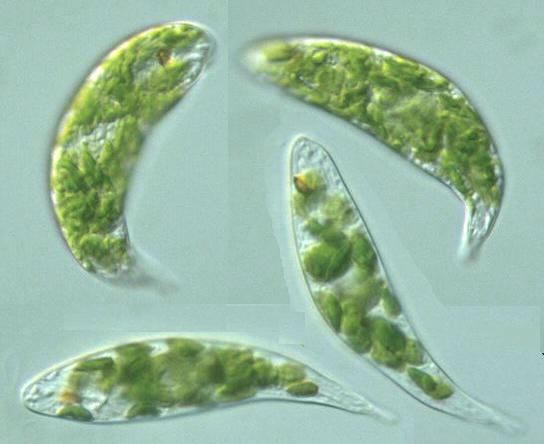
What is this? |
|
Euglena |
| |
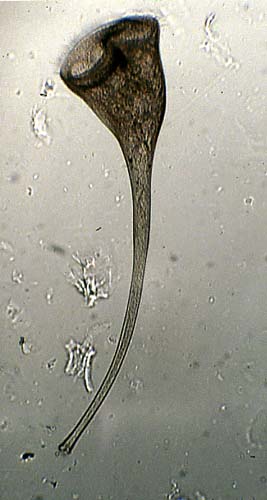
What is this? |
|
Stentor |
| |

What is this? |
|
Actinosphaerium |
| |

What is this? |
|
Volvox |
| |

What is this? |
|
Chlamydomonas |
| |

What is this? |
|
Blepharisma |
| |

What is this? |
|
human sperm |
| |
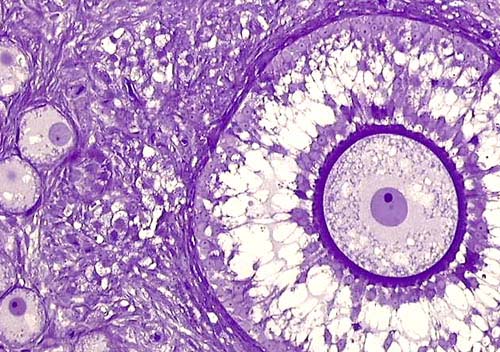
What is this? |
|
cat ovary |
| |
|
Explain the role of a Graafian follicle. |
|
The Graafian follicle is a mature follicle in an ovary. It is one of the largest follicles and will undergo ovulation. |
| |
|
What will an oocyte become if it is fertilized? |
|
an ovum |
| |
|
What surrounds an oocyte? Explain the role of this structure |
|
The zona pellucida surrounds an oocyte. It is equivalent to a fertilization membrane. |
| |
|
Name the two layers of the Graafian follicle. What do these layers do? |
|
granulosa and theca; these layers produce estrogen and progesterone |
| |
|
How can female pigs be externally distinguished? |
|
(1) by the presence of the genital papilla projecting from the urogenital orifice(2) by the location of the urogenital orifice: in females it is immediately ventral to the anal opening |
| |
|
How can male pigs be externally distinguished? |
|
(1) by the presence of scrotal sacs, which are swellings located beneath the anal opening(2) by the absence of the genital papilla(3) by the location of the urogenital orifice: located just posterior to the umbilical cord |
| |
|
What is the genital papilla? |
|
a fleshy tubercle that projects from the urogenital orifice in female pigs |
| |
|
What is the cervix? |
|
a short, narrow portion of the lower uterine duct with a thickened ring of tissue; found only in females |
| |
|
What is the fascia? |
|
the connective tissue that binds the vagina and the urethra together in females; connective tissue that connects to the penis in males |
| |
|
In male pigs, what do the vas deferens serve as? |
|
sperm ducts |
| |
|
What is the function of the prostate, seminal vesicles, and the bulbourethral glands? |
|
These structures secrete the fluid that suspends the sperm. |
| |
|
Where are the epididymis and the testes found? |
|
in the scrotal sac (scrotum) |
| |
|
What are the functions of the epididymis and the testes? |
|
Sperm are produced in the testes and stored in the epididymis while they mature. |
| |
|
What is the urogenital system composed of? |
|
the reproductive and excretory systems |
| |
|
Name the 2 major functions of the excretory system |
|
(1) to filter metabolic waster products from the blood(2) to maintain proper osmotic concentrations in the tissues of the body |
| |
|
What is the function of the kidneys? |
|
to filter the blood |
| |
|
What is the function of the urinary bladder? |
|
to store urine before elimination through the urethra |
| |
|
What is the function of the adrenal glands and where are they found? |
|
They are found at the anterior end of each kidney. They are composed of two separate glands, the cortex and the medulla, and produce hormones like norepinephrine and epinephrine. |
| |
|
What forms the urogenital sinus? |
|
the urethra joined with the vagina in female pigs |
| |
|
The circulatory system is composed of what 5 structures? |
|
blood, heart, arteries, veins, and capillaries |
| |
|
What is the difference between pulmonary circulation and systemic circulation? |
|
The pulmonary circulation carries blood from the heart to the lungs and back to the heart while the systemic circulation moves blood from the heart to the body and back to the heart. |
| |
|
What are the walls of the capillaries composed of? What occurs in the capillaries? |
|
The capillaries are composed of a single layer of smooth endothelium. It is in these capillaries where gas and nutrient exchange takes place between the tissues and the blood. |
| |
|
What is the function of the lymphatic system? What does the lymphatic system consist of? |
|
to transport fluids; consists of lymphatic vessels and lymph nodes |
| |
|
Describe the function of the lymphatic vessels. |
|
to collect interstitial fluids and proteins that have escaped from vascular capillaries |
| |
|
What are lymph nodes composed of? Describe their function. |
|
they are composed of reticular tissue which contains phagocytic cells; their function is to purify lymph fluid |
| |
|
What is the pericardium? |
|
the thick membrane that surrounds the heart |
| |
|
What is pericarditis? |
|
inflammation of the pericardium |
| |
|
What can be seen on the surface of the heart? What are the functions of these structures? |
|
the coronary arteries and veins; these structures deliver oxygen to and remove carbon dioxide from the heart muscle itself |
| |
|
Describe a heart attack. |
|
The coronary arteries and veins become clogged with plaque or a clot. No oxygen reaches the heart muscle, and the heart tissues may die. |
| |
|
What structures does the right atrium receive blood from? What are the functions of these structures? |
|
the superior (cranial) vena cava and the inferior (caudal) vena cava; they are large veins that transport blood from the anterior and posterior regions of the body, respectively |
| |
|
What is another word for atrium? |
|
auricle |
| |
|
What is the function of the aorta? |
|
to disseminate blood throughout the body |
| |
|
Describe the two differences in blood circulation before and after birth in pigs. |
|
(1) oxygen is obtained from the mother via the placenta, rather than the lungs; blood is diverted through the foramen ovale from the right atrium directly to the left atrium, which allows the blood to bypass the pulmonary circuit(2) the ductus arteriosus joins the pulmonary trunk and the aorta to also bypass the lungs |
| |
|
Upon birth, what two circulatory structures become inactive in pigs? |
|
the foramen ovale closes and the ductus arteriosus shrinks into a nonfunctional ligament |
| |
|
Describe arteries in comparison to veins. |
|
Arteries are smaller in diameter, thicker-walled, and very muscular compared to veins. In arteries, blood is under higher pressure. |
| |
|
What is the main artery leaving the heart? |
|
the aorta |
| |
|
What does the aorta leave the heart as? |
|
the aortic arch, which then turns posteriorly |
| |
|
What structure collects blood from the hind limbs and posterior body parts? |
|
inferior/caudal vena cava |
| |
|
What is a portal vein? |
|
A vein that directly connects the capillary networks of two different organs, rather than returning the blood to the heart first. |
| |
|
What is a mesentery? |
|
A membrane that suspends organs inside vertebrate's fluid-filled body cavities to prevent too much jostling around as we move. |
| |
|
What are the right and left renal arteries? |
|
arteries that branch off the aorta and lead directly to the kidneys |
| |
|
What are the right and left renal veins? |
|
veins that collect blood from the kidneys and deliver it back to the inferior vena cava |
| |
|
What structure collects blood from anterior body parts? |
|
superior (cranial) vena cava |
| |
|
What are the umbilical arteries? |
|
arteries that run along the edge of the urinary bladder to the umbilical cord |
| |
|
How many umbilical arteries and veins are there? |
|
2 umbilical arteries, 1 umbilical vein |
| |
|
How much magnification does the ocular lens provide? |
|
10X |
| |
|
magnification of the scanning objective |
|
4X |
| |
|
magnification of the low power objective |
|
10X |
| |
|
magnification of the high power objective |
|
40X |
| |
|
magnification of the immersion lens objective |
|
100X |
| |
|
What is the working distance? |
|
the distance between the tip of the object lens and the slide |
| |
|
What is the field of view? |
|
the diameter of the circle of light you see through the scope |
| |
|
What is resolution? |
|
the minimum distance between two objects when they are still perceived as two distinct objects |
| |
|
What is the formula for resolution? |
|
R = 0.61 (lambda)/ 2NA |
| |
|
Typical value of wavelength of light? |
|
500 nm |
| |
|
What is the numerical aperture mentioned on the microscope? |
|
The NA has to do with the collection of light by the lens and improves resolution if you have the largest value of NA possible. The NA is based on the refractive index of the substance between the objective lens and the object and (mu), which is 1/2 the angle of cone of light that can be gathered by the objective lens when focused on the object being studied. |
| |
|
What is a protist? |
|
eukaryotes that live their whole lives as a single cell |
| |
|
What two features do protists have in common? |
|
the strategies they use to survive and the constraints of being unicellular |
| |
|
What is the difference between protists and multicellular organisms? |
|
Instead of using organs to perform basic functions, they use cell structures including the nucleus, cilia and flagella, contractile vacuoles, or other membrane-bound structures. |
| |
|
Name three ways/structures that protists can use to move. |
|
flagella, cilia, pseudopods |
| |
|
What is flagella? |
|
1 to a few long whip-like structures |
| |
|
What is cilia? |
|
many small whip-like structures |
| |
|
What are flagella and cilia composed of? What is this? |
|
microtubules: hollow tubes composed of the protein tubulin |
| |
|
Describe flagella movement. |
|
Flagella move with a whip-like motion. The flagellum is held forward ahead of the cell and the whip-like beat is backwards creating a current that pulls the cell forward. |
| |
|
Describe cilia movement. |
|
The cilium is held rigid and pushes backwards to propel the cell forward (the power stroke). On the return stroke, the cilium is flexed so that it does not push the cell backwards. Sometimes, the cilia are fused together into little legs called cirri that the cell uses to walk along a surface. |
| |
|
What material does pseudopodia movement use? What is the material made up of? |
|
This type of motion uses microfilaments and each is made up of two intertwined strands of the protein actin. The strands can grow or shrink at either end by the addition or subtraction of actin molecules. |
| |
|
Describe pseudopod movement. |
|
The cytoplasm at the core of the cell, called plasmasol, is relatively liquid, but beneath the cell membrane the cytoplasm is much thicker and is called plasmagel. To form a pseudopod: 1) the thick plasmagel in one area of the cell thins, allowing a bulge (the pseudopod) to form 2) under the cell surface, the network of microfilaments in the plasmagel interacts to squeeze the thinner plasmasol into the bulge 3) as the microfilaments contract, the cytoplasm streams into the pseudopod, and the pseudopod extends4) eventually the cytoplasm at the leading edge of the pseudopod is converted into firm plasmagel and the pseudopod stops streaming |
| |
|
How does elimination of metabolic wastes in protists take place? |
|
by simple diffusion across the cell membrane |
| |
|
What is the purpose of contractile vacuoles? What do they consist of? |
|
to maintain the proper balance of water and salt in single-celled organisms; they consist of membrane bound tubes that empty into a large collecting vacuole |
| |
|
What are the types of nutrition in protists? |
|
Some are autotrophic (make their own food from light energy through photosynthesis) and others are heterotrophic (ingest food from the environment), and some are both. |
| |
|
What is the function of food vacuoles? |
|
they are used by protists to engage in pinocytosis or engulf solid food |
| |
|
What do most heterotrophic protists eat? |
|
most take in solid foods such as organic detritus or whole prey by phagocytosis |
| |
|
Where do food vacuoles form in protists? |
|
at any site on the cell surface or at particular sites associated with a cytosome ("cell mouth"), as they do in protists with relatively fixed shapes |
| |
|
What do protists have to protect them? |
|
They secrete protective cysts which are protective coatings. When food appears, they break out of the cysts, and when it disappears, they secrete the cyst again and go dormant. |
| |
|
What predatory ciliate can detect injured animals and has teeth-like projections? |
|
Coleps |
| |
|
How do photosynthesis protists sense light? |
|
By using their flagellum, which contains light-reactive chemicals, and a light-blocking structure, called an eyespot or stigma |
| |
|
How do protists sense light? |
|
through several structures such as cilia and flagella, which are touch and chemical sensitive organelles; some also respond to light, including photosynthetic protists, which sense light though eyespots called stigma |
| |
|
What is a dichotomous key? |
|
A system that's been set up to identify organisms by their characteristics. |
| |
|
What is the numerical aperture of scanning power lens? |
|
.1 |
| |
|
What is the numerical aperture of low power lens? |
|
.25 |
| |
|
What is the numerical aperture of high power lens? |
|
.65 |
| |
|
What is the numerical aperture of oil immersion lens? |
|
1.25 |
| |
|
What does the iris diaphragm adjust? |
|
the light in a microscope |
| |
|
What is a euglena? |
|
small, freshwater protists that contain chloroplasts but can also feed as heterotrophs |
| |
|
What unique structure does a euglena have? |
|
paramylum: a complex carbohydrate used in place of starch for energy storage |
| |
|
How do euglena reproduce? What is their nucleus? |
|
They reproduce asexually and their nucleus is haploid. |
| |
|
Two things that influence the body plan in animals and other life forms. |
|
evolution and habitat |
| |
|
What is a tissue? |
|
a group of cells with a common structure and function |
| |
|
What are the most important tissues? |
|
the primary germ layers in animal embryos: the ectoderm, mesoderm, and endoderm |
| |
|
What is the ectoderm? What does it give rise to? |
|
the outermost layer of embryonic tissue; gives rise to the outer covering of the adult organisms and in some cases, also to its nervous system, inner ear, and the lens of the eye |
| |
|
What is the mesoderm? What does it give rise to? |
|
the middle embryonic later; develops into the muscles, skeleton, gonads, kidneys, the lining of the body cavity, and most of the circulatory system |
| |
|
What is the endoderm? What does it give rise to? |
|
inner most embryonic layer; develops into the liver, pancreas, lungs, and the lining of the digestive tract |
| |
|
What invertebrate phyla have radial symmetry? |
|
Phyla Cnidaria and Ctenophora; the rest have bilateral symmetry |
| |
|
What is a coelom? What do acoelomates have instead of a coelom? What do true coelomates have? What do pseudocoelomates have? |
|
a body cavity (space) between the digestive tract and the body wall; acoelomates have solid cells; true coelomates have a body cavity lined by a mesoderm; pseudocoelomates also have a coelom, but it is not completely lined by mesoderm |
| |
|
What are members of the Lophotrochozoa distinguished by? |
|
a distinct feeding structure called a lophophore or a unique larval stage (a trochophore larva) |
| |
|
What is the difference between small organisms and large organisms (invertebrates)? |
|
Large organisms must rely on more organ systems to carry out many of life's essential functions (move gases, nutrients, and wastes in and out). Smaller organisms are able to exchange gases and waste because diffusion across the surface is no problem (due to large surface area-to-volume ratio). |
| |
|
What must sessile animals be aware of? What do they have to prevent this? |
|
sessile = non-moving/slow-moving animals; must be aware of potential predators or prey from all sides; show radial symmetry and have their sensory structures distributed around their bodies |
| |
|
What are rapidly moving animals concerned with? What do they have? |
|
more concerned about the environment they are moving into; show bilateral symmetry with cephalization (head formation with a concentration of sensory organs) |
| |

What is this? |
|
Phylum Porifera - freshwater sponge |
| |
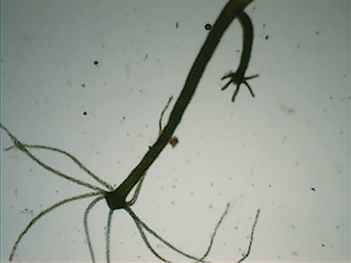
What is this? |
|
Phylum Cnidaria - Hydra |
| |

What is this? |
|
Phylum Cnidaria - Coral |
| |

What is this? |
|
Phylum Rotifera |
| |

What is this? |
|
Phylum Platyhelminthes - Planaria |
| |
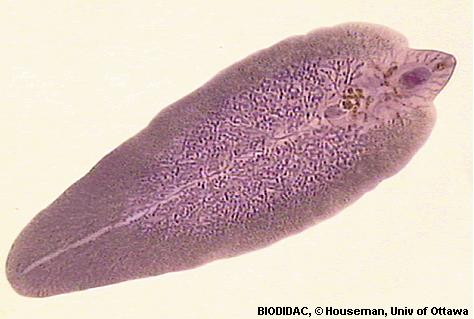
What is this? |
|
Phylum Platyhelminthes - sheep liver fluke |
| |

What is this? |
|
Phylum Nematoda - live vinegar eels |
| |

What is this? |
|
Phylum Nematoda - Ascaris slide showing male and female dimorphism |
| |

What is this? |
|
Phylum Mollusca - live slug |
| |

What is this? |
|
Phylum Mollusca - octopus |
| |

What is this? |
|
Phylum Mollusca - clam |
| |
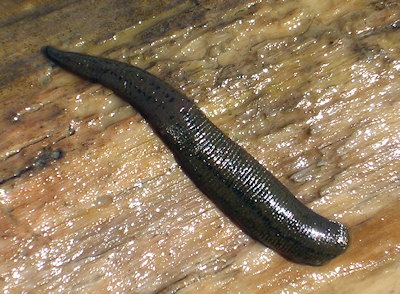
What is this? |
|
Phylum Annelida - leech |
| |

What is this? |
|
Phylum Annelida - earthworm |
| |

What is this? |
|
Phylum Arthropoda - madagascar hissing cockroaches |
| |

What is this? |
|
Phylum Arthropoda - spider |
| |

What is this? |
|
Phylum Arthropoda - crayfish |
| |
